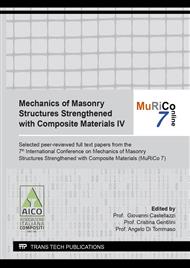[1]
M.A. Aiello, A. Cascardi, Design formulas for FRCM strengthened masonry elements under compression or shear load, ACI SP 345 (2021) 143-155.
DOI: 10.14359/51731577
Google Scholar
[2]
A. D'Ambrisi, F. Focacci, Flexural strengthening of RC beams with cement-based composites, J. Compos. Constr. 15 (2011) 707–720.
DOI: 10.1061/(asce)cc.1943-5614.0000218
Google Scholar
[3]
T. D'Antino, A.S. Calabrese, C. Poggi, P. Colombi, G. Fava, M. Bocciarelli, Strengthening of different types of slabs with composite-reinforced mortars (CRM), in: S. Della Torre, M. Bocciarelli, L. Daglio, R. Neri (Eds.), Research for Development, Springer, Milano, 2020, p.293–303.
DOI: 10.1007/978-3-030-33687-5_26
Google Scholar
[4]
A.S Calabrese, T. D'Antino, P. Colombi, C. Carloni, C. Poggi, Fatigue behavior of FRCM strengthened RC beams: state of the art and future developments: submitted to CICE 2020 Conference Proceedings (2021).
DOI: 10.1007/978-3-030-88166-5_16
Google Scholar
[5]
A.S. Calabrese, T. D'Antino, P. Colombi, C. Carloni, C. Poggi, Fatigue behavior of PBO FRCM composite applied to concrete substrate, Materials 13 (2020).
DOI: 10.3390/ma13102368
Google Scholar
[6]
H.A. Hadad, A. Nanni, U.A. Ebead, A. El Refai, Static and fatigue performance of FRCM-strengthened concrete beams, J. Compos. Constr. 22 (2018).
DOI: 10.1061/(asce)cc.1943-5614.0000868
Google Scholar
[7]
F. Micelli, M.A. Aiello, Residual tensile strength of dry and impregnated reinforcement fibres after exposure to alkaline environments, Compos. Part B 159 (2019) 490–501.
DOI: 10.1016/j.compositesb.2017.03.005
Google Scholar
[8]
J. Machovec, P. Reiterman, Influence of aggressive environment on the tensile properties of textile reinforced concrete, Acta Polytechnica 58 (2018) 245–252.
DOI: 10.14311/ap.2018.58.0245
Google Scholar
[9]
F.G. Carozzi, P. Colombi, T. D'Antino, C. Poggi, Durability of textile reinforced mortar (TRM) systems, Proc. of the 9th International Conference on Fibre-Reinforced Polymer (FRP) Composites in Civil Engineering - CICE 2018, (2018) 322–329.
DOI: 10.1007/978-3-030-88166-5_180
Google Scholar
[10]
J. Donnini, Durability of glass FRCM systems. Effects of different environments on mechanical properties, Compos Part B 174 (2019).
DOI: 10.1016/j.compositesb.2019.107047
Google Scholar
[11]
Consiglio superiore dei lavori pubblici, Servizio tecnico centrale. Linea Guida per la identificazione, la qualificazione ed il controllo di accettazione di compositi fibrorinforzati a matrice inorganica (FRCM) da utilizzarsi per il consolidamento strutturale di costruzioni esistenti, (2018).
DOI: 10.3221/igf-esis.12.04
Google Scholar
[12]
ICC Evaluation Service. Acceptance criteria for masonry and concrete strengthening using fiber-reinforced cementitious matrix (FRCM) composite systems. AC434 (2013).
DOI: 10.14359/51702356
Google Scholar
[13]
Sika Italia SpA. Sika MonoTop®-722 Technical Sheet. (2021).
Google Scholar
[14]
Sika Italia SpA. SikaWrap®-340 G Grid AR Technical Sheet. (2021).
Google Scholar
[15]
ASTM International. Standard Practice for Preparation of Substitute Ocean Water. ASTM D1141 - 98. ASTM International (2021).
Google Scholar
[16]
F. Focacci, T. D'Antino, C. Carloni, The role of the fiber–matrix interfacial properties on the tensile behavior of FRCM coupons, Construction and Building Materials 256 (2020) 1–13.
DOI: 10.1016/j.conbuildmat.2020.120263
Google Scholar
[17]
K. Al-Lami, T. D'Antino, P. Colombi, Durability of fabric-reinforced cementitious matrix (FRCM) composites: A Review, Applied Sciences 10 (2020).
DOI: 10.3390/app10051714
Google Scholar
[18]
V.K.R. Kodur, P.P. Bhatt, M.Z. Naser, High temperature properties of fiber reinforced polymers and fire insulation for fire resistance modeling of strengthened concrete structures, Compos. Part B 175 (2019).
DOI: 10.1016/j.compositesb.2019.107104
Google Scholar


